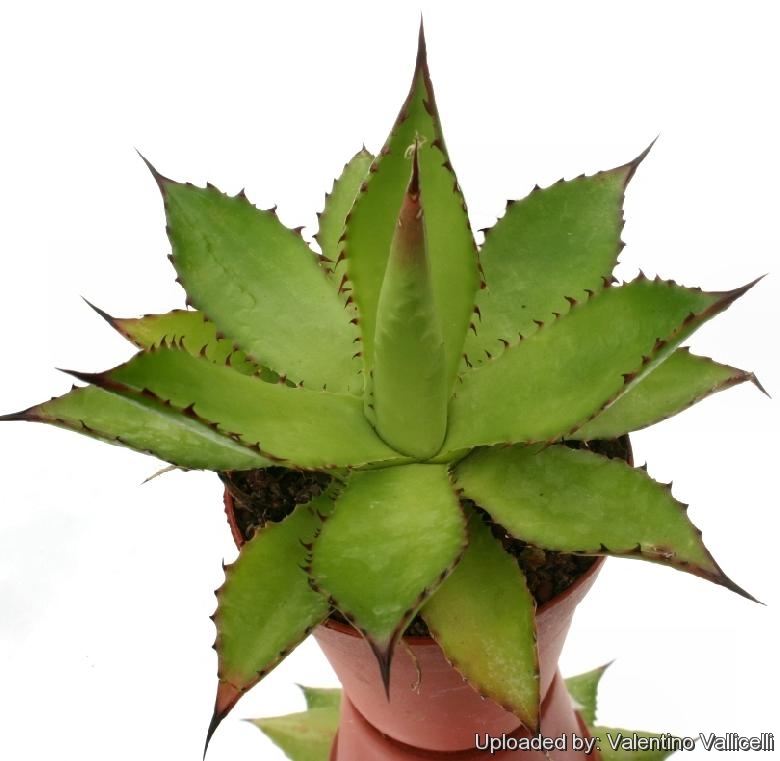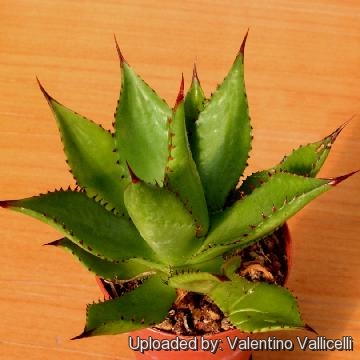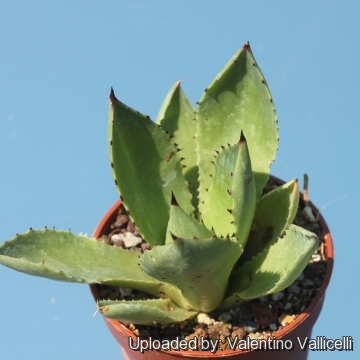
Agave obscura Photo by: Valentino Vallicelli
Origin and Habitat: Agave obscuraSN|521]]SN|521]] is found scattered over a vast area in central eastern Mexico, where it grows in the states of Oaxaca, Puebla, San Luis Potosi, Tamaulipas and Veracruz.
Habitat and ecology: It grows on rocky outcrops (granite, basalt and some other rocks) together with, Hechtia roseana, Nolina parvifloraSN|33540]]SN|33540]] and Yucca periculosaSN|29988]]SN|29988]].
Synonyms:
See all synonyms of Agave obscura
back
Accepted name in llifle Database:Agave obscura SchiedeLinnaea 5: 464 1830; et 18: 413. 1845Synonymy: 13
back
Common Names include:
ENGLISH: Century plant, Hardy Century Plant, Red-flowered hardy agave, Whale's Tongue Agave
Description: Agave obscura is a medium-sized Agave forming a spreading, sometimes suckering rosette to about 1m in diameter, consisting of broad, soft, light green leaves with small, reddish teeth along the margins. Christian Julius Wilhelm Schiede already described Agave obscuraSN|521]]SN|521]] but the name was validly published by Diederich Franz Leonhard von Schlechtendal. The name A. obscura has been misapplied in the past and many plants in cultivation as A. obscura are in fact Agave horrida ssp. perotensis. The latter has dark green leaves with prominent, white thorns along the margins and is thus easy to distinguish from the real A. obscura.
Derivation of specific name: With an epithet like obscura one may be tempted to think that this agave is uncommon in cultivation, and that is indeed the case. However, the name alludes to the less showy dark reddish colour of the flowers compared to the brilliant yellow of many other agaves.
Leaves: 25-40 cm long, 5-8 cm, variable, broadly linear to ovate, rigid, straight to curved upwards, plane to somewhat hollowed above, smooth, pale green to green. Margin, continuous, straight to undulate between teeth, grey. Teeth straight to curved or flexible, frequently down slanted and curved, 3-15 mm long, 1-3 cm apart, flattened, all grey: Apical spine 3-5 cm long broadly decurrent, grey.
Inflorescence: 3-5 m tall, densely flowered in upper fourth in a spiralling sequence; bracts broad at base longer than flowers. Pedicels short.
Flowers; 34-41 mm long, dark purple or red or yellow; ovary 16-21 mm long, with short thick neck. Tube short, spreading 3-4 mm long. Tepals linear, 15-17 linear, 4-7 mm wide, erect to slightly recurved. Filaments 40-50 mm long, slender, inserted on rim of tube. Anthers 14-18 mm long varicolored
Fruits (loculicidal capsules: 2.5-3 cm long, 1-1.4 cm broad, oblong, rounded at base and apex, without beak.
Seeds: 3-4 long, 1.5-2.5 mm wide, dull black, the marginal wing low, narrow.
Bibliography: Major references and further lectures
1) Gentry, H. S. “Agaves of continental North America.” 1982.
2) Cactus and Succulent Journal, Volume 75(1-6): 24 2003
3) Walter Erhardt, Erich Götz, Nils Bödeker, Siegmund Seybold “Der große Zander.” Eugen Ulmer KG, Stuttgart 2008
4) Christoper Brickell (Editor-in-chief) “RHS A-Z Encyclopedia of Garden Plants.” Third edition. Dorling Kindersley, London 2003
 Agave obscura Photo by: Valentino Vallicelli
Agave obscura Photo by: Valentino Vallicelli Agave obscura Photo by: Valentino Vallicelli
Agave obscura Photo by: Valentino VallicelliCultivation and Propagation: Agave obscura is a stunning specimen plant for containers or a well drained spot in the garden. It tend to be slow grower, but worth the effort. Grow it in porous soil with adequate drainage. It do well in full sun or a lightly shaded area. Water thoroughly when soil is dry to the touch. In winter watering this plant can be done once every 1-2 months, there is no need to mist the leaves.
Hardiness: It is theoretically hardy to -3° C (or less), particularly when dry but it is best to avoid severe freezing temperatures.
Heat Tolerance: Good.
Uses: These striking plants are wonderful when used for accent or simply to provide some all year round foliage colour and often used in a pot as a patio plant, they make an eye-catching statement and along with other evergreen plants in pots, can be moved around to change the scenery or position to give more shelter.Uses: These striking plants are wonderful when used for accent or simply to provide some all year round foliage colour and often used in a pot as a patio plant, they make an eye-catching statement and along with other evergreen plants in pots, can be moved around to change the scenery or position to give more shelter.
Propagation: Relatively easy to propagate by seeds or by suckers (if available) Remove the basal suckers in spring or summer and let the cuttings dry for a few days before inserting in compost.. only problem is the logistics of getting to the suckers - very sharp spines and suckers usually right up against, or underneath the mother plant.












